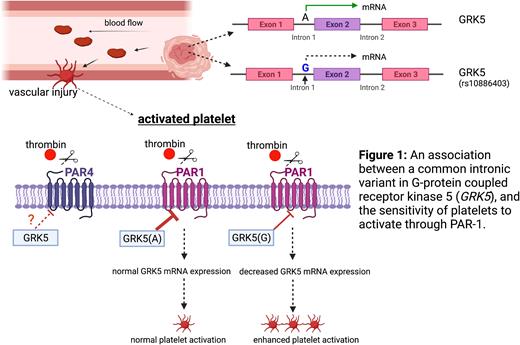Abstract
Two separate genome wide association studies (GWAS), recently conducted by our group and another group, have identified the variant rs10886430 in the G protein-coupled receptor kinase 5 (GRK5) gene with a minor allele frequency of ~14% in Caucasians. Both studies show that the variant resides in a megakaryocyte-specific enhancer that alters the binding of the transcription factors GATA1 and MEIS1. In contrast to the major allele (A), the minor allele (G) is associated with decreased GRK5 mRNA expression, increased platelet reactivity, and greater risk of cardiovascular disease. However, the effect of the variant on protein expression has not been investigated by either group. In addition, there is an inconsistency between the findings of each of the studies regarding the specific role of GRK5 in thrombin receptor PAR1- and PAR4-mediated platelet activation. Further studies are needed to clarify whether, and how, GRK5 regulates platelet activity via PAR1, PAR4, or both.
Here we introduce the A>G mutation into a megakaryoblastic cell line, Meg-01, by CRISPR-Cas9 genome editing. GRK5 protein expression is decreased by 80% in A>G mutant Meg-01 cells compared to WT control cells. To determine whether GRK5 regulates PAR1, PAR4, or both, we have isolated human platelets and specifically blocked GRK5 activity with compound CCG273261 to compare platelet responses to PAR1- and PAR4-specific agonists. Our data show that pharmacological inhibition of GRK5 increases markers of platelet activation such as integrin activation and P-selectin surface exposure in response to PAR1 receptor agonist peptide. Platelet activation in response to PAR4 receptor agonist peptide is normal. Furthermore, this inhibition increases Ca2+ mobilization in response to PAR1 receptor agonist, but not to PAR4 receptor agonist. Consistent with the results of our functional assays, mass spectrometry analysis revealed an interaction between GRK5 and PAR1 but did not detect an interaction with PAR4.
Collectively, our data show that 1) this GRK5 intronic variant regulates GRK5 expression at both transcriptional and translational levels, 2) GRK5 preferentially regulates PAR-1 over PAR4-mediated signaling, and 3) GRK5 has a binding interaction with PAR1 (Fig 1). Our findings will enable us to develop superior therapeutics for cardiovascular risk groups especially those individuals who carry the intronic variant in GRK5 and as a result are more likely to experience thrombotic events.
Disclosures
No relevant conflicts of interest to declare.
Author notes
Asterisk with author names denotes non-ASH members.


This feature is available to Subscribers Only
Sign In or Create an Account Close Modal